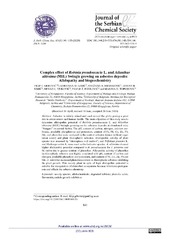Приказ основних података о документу
Complex effect of Robinia pseudoacacia L. and Ailanthus altissima (Mill.) Swingle growing on asbestos deposits: Allelopathy and biogeochemistry
| dc.creator | Grbović, Filip | |
| dc.creator | Gajić, Gordana | |
| dc.creator | Branković, Snezana | |
| dc.creator | Simić, Zoran | |
| dc.creator | Vuković, Nenad | |
| dc.creator | Pavlović, Pavle | |
| dc.creator | Topuzović, Marina | |
| dc.date.accessioned | 2020-07-02T11:49:12Z | |
| dc.date.available | 2020-07-02T11:49:12Z | |
| dc.date.issued | 2020 | |
| dc.identifier.issn | 0352-5139 | |
| dc.identifier.uri | http://www.doiserbia.nb.rs/Article.aspx?ID=0352-51391900062G | |
| dc.identifier.uri | https://radar.ibiss.bg.ac.rs/handle/123456789/3721 | |
| dc.description.abstract | Asbestos is widely mined and used around the globe posing a great risk to environment and human health. The main objective of this study was to determine allelopathic potential of Robinia pseudoacacia L. and Ailanthus altissima (Mill.) Swingle growing on the asbestos deposits at abandoned mine “Stragari” in central Serbia. The pH, content of carbon, nitrogen, calcium carbonate, available phosphorous and potassium, content of Fe, Ni, Cu, Zn, Pb, Mn, and phenolics were analyzed in the control asbestos (zones without vegetation cover) and plant rhizospheric asbestos. Allelopathic activity of plant species was assessed by “rhizosphere soil method”, and Trifolium pratense L. and Medicago sativa L. were used as the indicator species. A. altissima showed higher allelopathic potential compared to R. pseudoacacia for T. pratense and M. sativa due to greater content of phenolics. Alleopathic activity of phenolics in rhizospheric asbestos was highly correlated with pH, content of carbon and nitrogen, available phosphate and potassium, and content of Ni, Cu, Zn, Pb and Mn. A. altissima increased phenolics content in rhizospheric asbestos inhibiting the plant growth. This woody plant in spite of high allelopathic potential is suitable for revegetation of distrurbed ecosystems because it initiates pedogenesis and affects the asbestos chemistry. | en |
| dc.relation | info:eu-repo/grantAgreement/MESTD/Integrated and Interdisciplinary Research (IIR or III)/41010/RS// | |
| dc.relation | info:eu-repo/grantAgreement/MESTD/Basic Research (BR or ON)/173018/RS// | |
| dc.rights | openAccess | |
| dc.rights.uri | https://creativecommons.org/licenses/by-nc-nd/4.0/ | |
| dc.source | Journal of the Serbian Chemical Society | |
| dc.subject | Woody species | |
| dc.subject | Allelochemicals | |
| dc.subject | Degraded habitats | |
| dc.subject | Phenolic acids | |
| dc.subject | Flavonoids | |
| dc.subject | Radicle growth inhibition | |
| dc.title | Complex effect of Robinia pseudoacacia L. and Ailanthus altissima (Mill.) Swingle growing on asbestos deposits: Allelopathy and biogeochemistry | en |
| dc.type | article | en |
| dc.rights.license | BY-NC-ND | |
| dcterms.abstract | Вуковић, Ненад; Симић, Зоран; Павловић, Павле; Гајић, Гордана; Бранковић, Снезана; Грбовић, Филип; Топузовић, Марина; | |
| dc.rights.holder | © 2019 by the Serbian Chemical Society | |
| dc.citation.issue | 1 | |
| dc.citation.volume | 85 | |
| dc.identifier.doi | 10.2298/JSC190416062G | |
| dc.identifier.scopus | 2-s2.0-85094208020 | |
| dc.identifier.wos | 000514217400012 | |
| dc.citation.apa | Grbovic, F., Gajic, G., Brankovic, S., Simic, Z., Vukovic, N., Pavlovic, P., et al. (2020). Complex effect of Robinia pseudoacacia L. and Ailanthus altissima (Mill.) Swingle growing on asbestos deposits: Allelopathy and biogeochemistry. Journal of the Serbian Chemical Society, 85(1), 141–153. | |
| dc.citation.vancouver | Grbovic F, Gajic G, Brankovic S, Simic Z, Vukovic N, Pavlovic P, Topuzovic M. Complex effect of Robinia pseudoacacia L. and Ailanthus altissima (Mill.) Swingle growing on asbestos deposits: Allelopathy and biogeochemistry. J Serbian Chem Soc. 2020;85(1):141–53. | |
| dc.citation.spage | 141 | |
| dc.citation.epage | 153 | |
| dc.type.version | publishedVersion | |
| dc.identifier.fulltext | https://radar.ibiss.bg.ac.rs/bitstream/id/6306/bitstream_6306.pdf | |
| dc.citation.rank | M23 |

